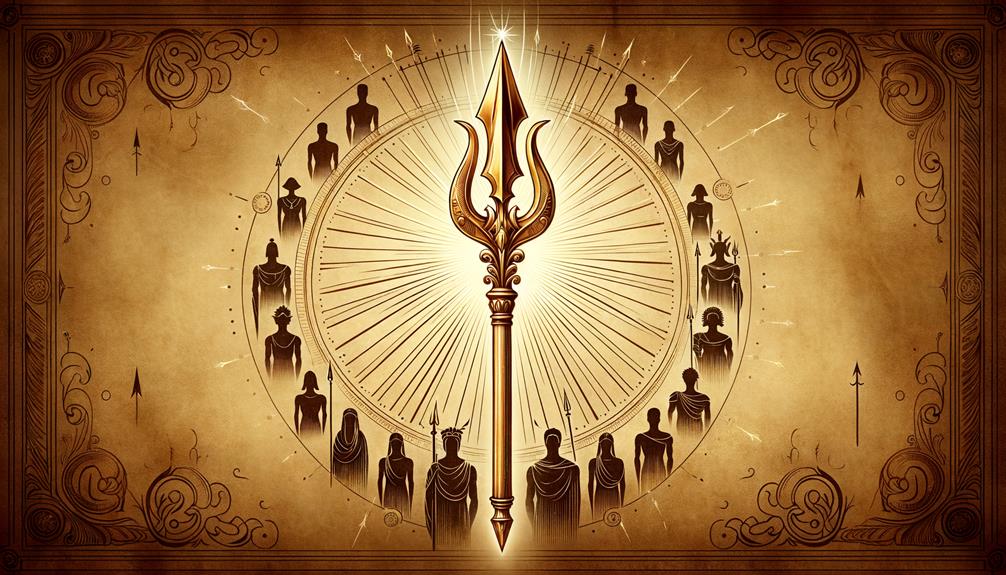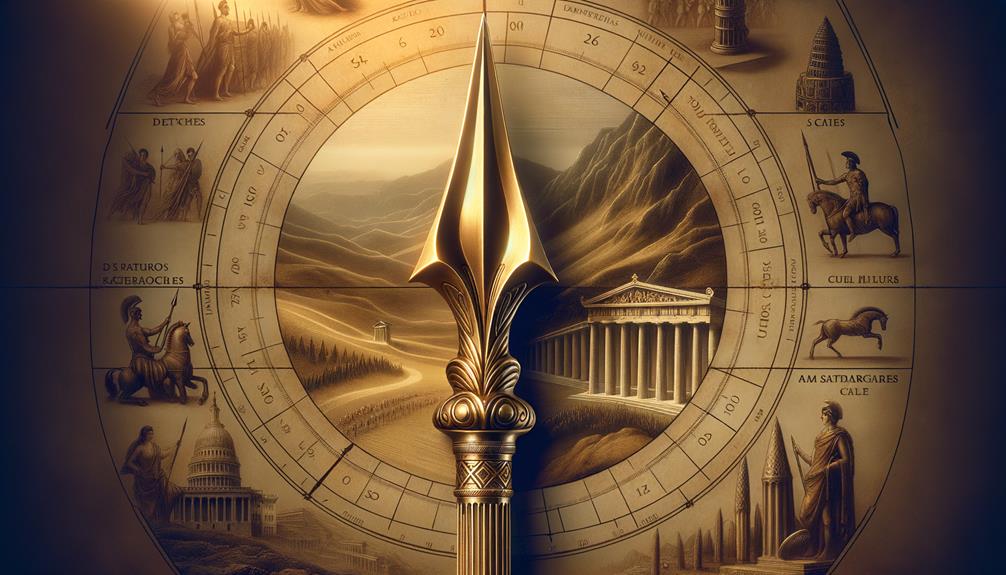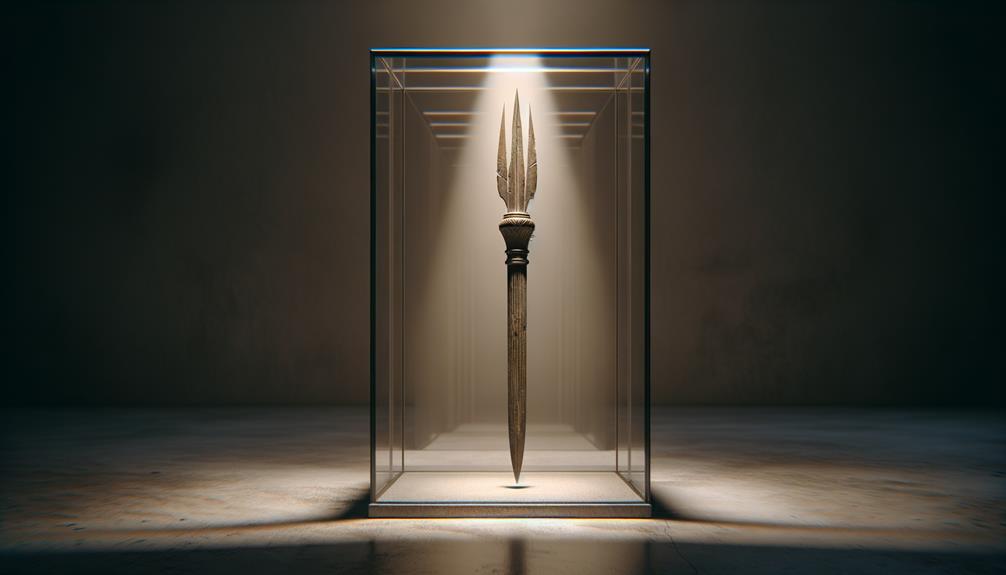The Spear of Longinus is a fascinating artifact from the Bible with a rich history that intertwines with both divine and human affairs. The story goes that Longinus used this spear to pierce the side of Christ. This act is seen as a symbolic union of human deeds and divine purpose in Christian tradition.
As time went on, the spear became an object of interest to many powerful figures in history. It was once held by the Holy Roman Emperors, caught Napoleon's attention, and even piqued Hitler's curiosity. The spear's journey doesn't halt there. It was shown off by Pope Innocent VIII and eventually ended up in the hands of American forces in 1945.
Although research hasn't been able to concretely prove its authenticity, it hasn't detracted from the spear's biblical importance. The path this spear has taken through history paints a compelling picture of the intersection of divine influence and human history. It's a tale that only grows more intriguing the more you learn about it.
The Biblical Significance of the Spear
You might think of the Spear of Longinus as just a piece of weaponry from the history books, but if you dig a little deeper, you'll find it has a much greater role in the Christian faith. It's not just any old spear; it's a sacred relic, a notable piece of Christian history. This very spear, held by a Roman soldier named Longinus, is mentioned in the Gospel of John, chapter 19, verses 33-34. The story goes that Longinus didn't break Jesus' legs as was the usual practice but instead chose to stab Jesus in the side to make sure he was dead.
But let's not just think of this spear as a weapon. It's a symbol of the suffering and sacrifice of Christ. The act of stabbing Jesus in the side, which might seem cruel, was actually part of a divine plan. It was the confirmation of Jesus' death, a crucial event that paved the way for his resurrection, a fundamental belief in Christianity. So, the Spear of Longinus is not just a spear; it's a powerful symbol in Christianity. It represents the meeting point of human actions and divine intent. Its historical and religious significance touches the hearts of believers, marking it as a cherished relic in the Christian faith.
Notable Owners of the Holy Lance

The Holy Lance, commonly referred to as the Spear of Longinus, carries a fascinating history. This old artifact, which is claimed to contain a nail from Christ's cross, has sparked interest throughout the ages as a symbol of power.
The Holy Roman Emperors had the Holy Lance in their possession since the 10th century. Its location in Vienna was seen as a divine endorsement of their rule. The relic, thought to grant invincibility, was secretly moved from Vienna to avoid being taken by Napoleon.
Speaking of Napoleon, this significant figure in history had a keen interest in the spear, understanding its symbolic value. But despite his efforts, he was unable to get his hands on it.
As we moved into the 20th century, Hitler, who had a known fascination with mystical artifacts, believed that the Holy Lance was crucial to his rise in power. Owning the Lance only added to his unfounded belief of being invincible.
However, in 1945, American forces seized the Lance, marking the end of its journey through power's corridors. The Spear has been a point of interest for everyone from emperors to dictators. Its allure has greatly influenced its intriguing history, serving as a testament to mankind's continuous quest for divine empowerment.
Documented Appearances in History

If we follow the breadcrumbs of the Holy Lance, also known as the Spear of Destiny, through history, it's like reading a gripping novel filled with faith, power, and key turning points. Its first recorded appearance is somewhat late in the game, showing up when Roman soldiers used it on Jesus Christ during his crucifixion. But once it enters the historical record, it's as if the lance takes on a life of its own, crisscrossing through time.
Let's break down some of its key appearances:
- 8th Century: Vatican City – Pope Innocent VIII proudly displays the Holy Spear for all to see.
- Late Middle Ages: Imperial Treasury, Vienna – The Holy Lance is discovered and held for safekeeping.
- 15th Century: Holy Roman Empire – Frederick III, the Holy Roman Emperor, comes into possession of the lance.
These moments in time give the lance an almost mystical quality, fascinating powerful figures like emperors and popes. The Holy Roman Empire, for instance, thought so highly of it that it was kept in the Imperial Treasury. Fast forward a few centuries, and Pope Innocent VIII is showing off the Holy Spear in Vatican City, further cementing its revered status. This timeline of the Spear of Destiny's appearances helps to underscore both its historic importance and spiritual value.
Scientific Investigations of the Spear

Let's go on a journey through the scientific lens focused on the Spear of Longinus, an artifact steeped in history. The Spear has been the subject of various scientific examinations throughout the years, each one challenging its historical relevance.
First off, in 2003, researchers performed an intensive analysis on the Spear in search of blood residue. Despite their efforts, they found no traces. This throws a curveball at assertions that this Spear is the one that pierced Christ's side. However, it doesn't completely rule out the possibility.
Next, the Spear's age was examined. The results suggested it dates back to the 7th century AD, which is significantly later than when Jesus was crucified.
One aspect that adds an interesting twist to the Spear's story is the 'Nail of Our Lord'. This piece, which is affixed to the Spear, has been confirmed to be a nail from the 1st century. This detail adds some credence to claims about the Spear's historical importance.
Among the four Holy Lances claimed to exist, the Vienna Spear, which is on display at the Imperial Treasury, has faced the most scientific scrutiny. Its authenticity continues to be a hot topic of debate. The scientific examination of the Spear has not only challenged its historical relevance but also sparked discussions about its authenticity.
Viewing the Spear Today

If you're interested in seeing a piece of legendary history, head over to the Imperial Treasury at the Hofburg Palace in Vienna. Here, the Holy Lance, or as it's sometimes called, the 'Spear in Vienna', is on show. This artifact resonates with a sense of divine fate and historical importance.
The Holy Lance is thought to come from the 8th century, which is why it's considered 'late'. It stands as a representation of the role a Roman soldier played in Jesus' crucifixion. According to the tale, this soldier used the lance to pierce Jesus' side, marking this relic's place in religious history.
But Vienna's Hofburg Palace isn't the only spot where you can see the Holy Lance. There's another one tucked away in Saint Peter's Basilica. This adds an extra dimension of mystery and sacredness. Both relics act as touching reminders of a key event in Christian history.
Frequently Asked Questions
What Is the Spear of Longinus Christianity?
You know, in Christian beliefs, the Spear of Longinus holds a deep meaning. This is the very spear that is said to have been used to confirm the death of Jesus when he was crucified. So, you can see why it's a major part of the narrative within the Christian faith.
Is Longinus in the Bible?
Well, the name Longinus isn't exactly found in the Bible. The name pops up from sources outside the Bible, not directly from it. People often connect him with the soldier who pierced Jesus' side, but this is more of a Christian tradition, not something that's written in the scriptures.
What Are the 7 Relics of Jesus?
The seven treasures associated with Jesus, as believed by many, consist of the Holy Cross, Holy Chalice, Crown of Thorns, Holy Shroud, Holy Veil, and the Sudarium. There's also one more item that completes the set. Each of these items carries a distinct place in the narrative of Christian history.
Was the Spear of Destiny Found?
Absolutely, there's a belief that the Spear of Destiny was uncovered during the First Crusade. But, the truth of it is still a hot topic for debate. Some scholars are all in, fully convinced it's the real deal. Others, though, aren't quite as sure and continue to probe its historical accuracy.


